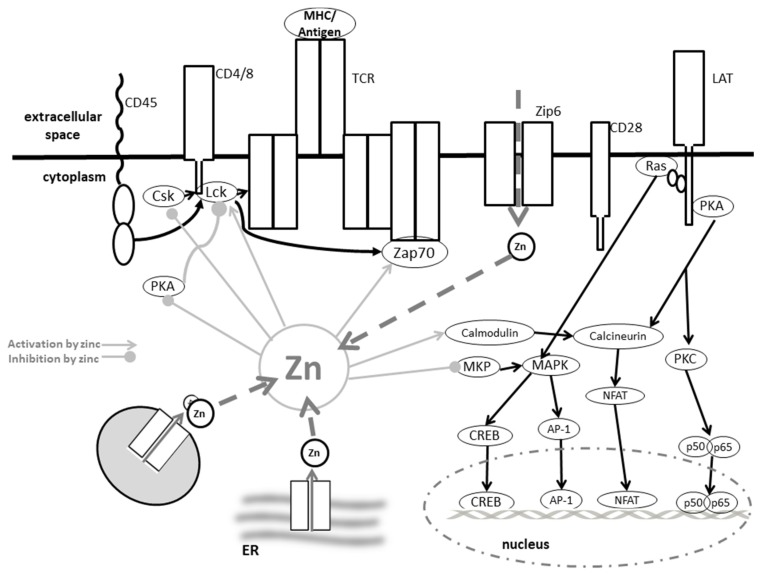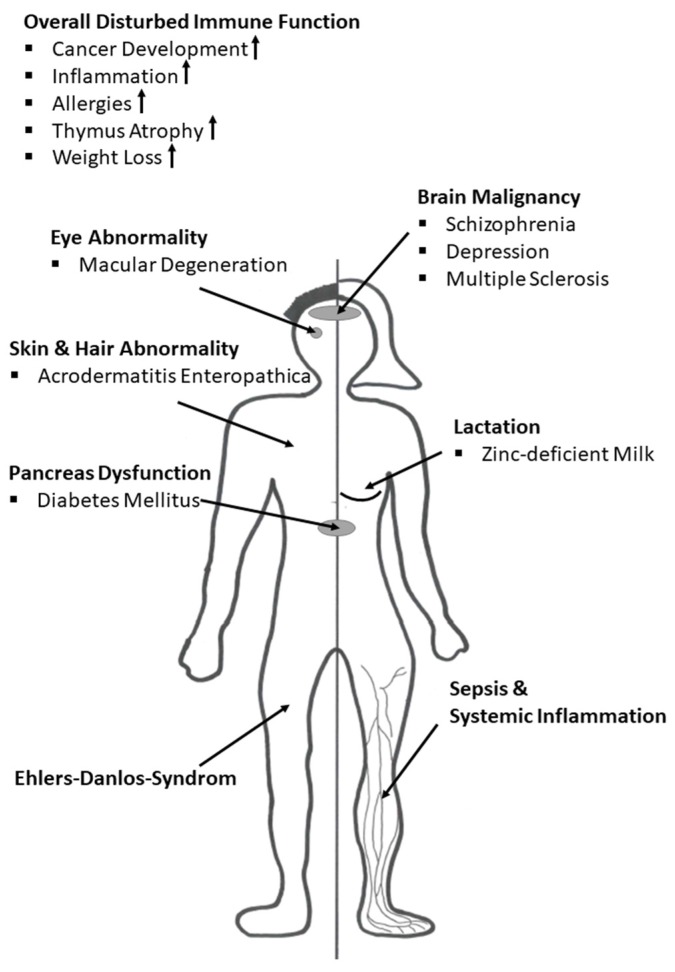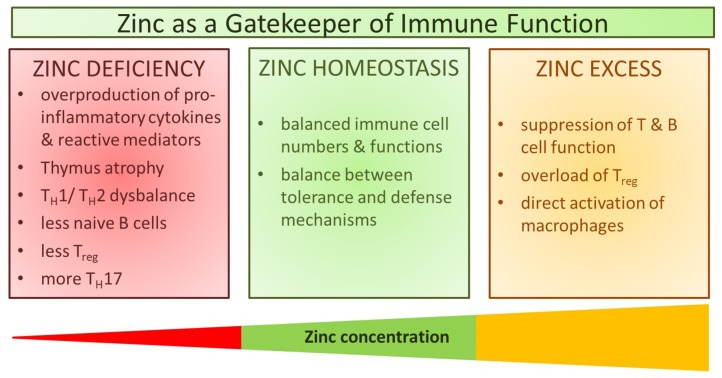Wessels Inga, Maywald Martina, Rink Lothar
Nutrients, 2017
Abstract
After the discovery of zinc deficiency in the 1960s, it soon became clear that zinc is essential for the function of the immune system. Zinc ions are involved in regulating intracellular signaling pathways in innate and adaptive immune cells. Zinc homeostasis is largely controlled via the expression and action of zinc "importers" (ZIP 1-14), zinc "exporters" (ZnT 1-10), and zinc-binding proteins. Anti-inflammatory and anti-oxidant properties of zinc have long been documented, however, underlying mechanisms are still not entirely clear. Here, we report molecular mechanisms underlying the development of a pro-inflammatory phenotype during zinc deficiency. Furthermore, we describe links between altered zinc homeostasis and disease development. Consequently, the benefits of zinc supplementation for a malfunctioning immune system become clear. This article will focus on underlying mechanisms responsible for the regulation of cellular signaling by alterations in zinc homeostasis. Effects of fast zinc flux, intermediate "zinc waves", and late homeostatic zinc signals will be discriminated. Description of zinc homeostasis-related effects on the activation of key signaling molecules, as well as on epigenetic modifications, are included to emphasize the role of zinc as a gatekeeper of immune function.
Keywords
homeostatic zinc signal; immune function; signaling pathways; zinc deficiency; zinc flux; zinc wave.
Conflict of interest statement
The authors declare that they have no conflict of interest.Figures
 Different Types of Zinc Signals: (A) Zinc Flux, as observed after receptor triggering (e.g., binding of lipopolysaccharide (LPS) to Toll like receptor (TLR)4), is generated within seconds. (B) A Zinc Wave, as is induced via immunoglobulin receptors and involving calcium flux, can be observed within a few minutes. (C) Homeostatic Zinc Signals, for example as observed after LPS stimulation of dendritic cells, take a few hours to be established and involve the expression of zinc transport and binding proteins. For explanations see the text. Abbreviations : ER: endoplasmic reticulum; ERK: extracellular signal-regulated kinase; MT: metallothionein; PLC: phospholipase c; R: receptor; Slp76, SH2 domain-containing leukocyte protein, 76 kD.
Different Types of Zinc Signals: (A) Zinc Flux, as observed after receptor triggering (e.g., binding of lipopolysaccharide (LPS) to Toll like receptor (TLR)4), is generated within seconds. (B) A Zinc Wave, as is induced via immunoglobulin receptors and involving calcium flux, can be observed within a few minutes. (C) Homeostatic Zinc Signals, for example as observed after LPS stimulation of dendritic cells, take a few hours to be established and involve the expression of zinc transport and binding proteins. For explanations see the text. Abbreviations : ER: endoplasmic reticulum; ERK: extracellular signal-regulated kinase; MT: metallothionein; PLC: phospholipase c; R: receptor; Slp76, SH2 domain-containing leukocyte protein, 76 kD.
 Zinc in Toll like receptor 4-induced signaling. For explanation, see text. Abbreviations : A20: zinc finger protein; AP-1: Activator protein 1; ERK: extracellular Signal-regulated Kinase; IFN: interferon; IRAK: Interleukin-1 receptor-associated kinase; IκB: Inhibitor of NFκB; IKK: IκB kinase; IRF: interferon related factor; JAK: JNK janus kinase; JNK: c-Jun N-terminal Kinase; LPS: Lipopolysaccharide; MAPK: mitogen activated protein kinases MEK: MAPK/Erk kinase; MKK: MAPK kinase; MKP: MAPK phosphatase; MyD88: Myeloid differentiation primary response gene; NFkB: nuclear factor (NF)κB; PI3K: phosphatidyl-inositol-3-phosphate; RIP: receptor interacting protein; STAT: Signal transducers and activators of transcription; TAB: TAK-binding protein; TAK: TGF β-activated kinase; TBK: Tank-binding kinase 1; TIRAP: toll-interleukin 1 receptor (TIR) domain containing adaptor protein; TLR: Toll like receptor; TRAF: TNF receptor-associated factor; TRAM: TRIF-related adaptor molecule; TRIF: Toll-interleukin-1 receptor (TIR) domain-containing adaptor-inducing interferon.
Zinc in Toll like receptor 4-induced signaling. For explanation, see text. Abbreviations : A20: zinc finger protein; AP-1: Activator protein 1; ERK: extracellular Signal-regulated Kinase; IFN: interferon; IRAK: Interleukin-1 receptor-associated kinase; IκB: Inhibitor of NFκB; IKK: IκB kinase; IRF: interferon related factor; JAK: JNK janus kinase; JNK: c-Jun N-terminal Kinase; LPS: Lipopolysaccharide; MAPK: mitogen activated protein kinases MEK: MAPK/Erk kinase; MKK: MAPK kinase; MKP: MAPK phosphatase; MyD88: Myeloid differentiation primary response gene; NFkB: nuclear factor (NF)κB; PI3K: phosphatidyl-inositol-3-phosphate; RIP: receptor interacting protein; STAT: Signal transducers and activators of transcription; TAB: TAK-binding protein; TAK: TGF β-activated kinase; TBK: Tank-binding kinase 1; TIRAP: toll-interleukin 1 receptor (TIR) domain containing adaptor protein; TLR: Toll like receptor; TRAF: TNF receptor-associated factor; TRAM: TRIF-related adaptor molecule; TRIF: Toll-interleukin-1 receptor (TIR) domain-containing adaptor-inducing interferon.
 Zinc in TCR-induced signaling. For explanation, see text. Abbreviations : AP-1: Activator protein 1; CREB: cAMP response element-binding protein; Csk: C-terminal Src kinase; ER: endoplasmic reticulum; Lck: lymphocyte-specific protein tyrosine kinase; LAT: linker for activation of T cells; MAPK: mitogen activated protein kinases; MHC: major histocompatibility complex; MKP: MAP kinase phosphatase; NFAT: Nuclear factor of activated T cells; p50/p56: nuclear factor NF-kappa-B subunit p50/p65; PKA: protein kinase A; PKC: protein kinase C; Ras: Rat sarcoma; TCR: T cell receptor; ZAP: z-chain-associated protein kinase; Zip: Zrt-like, Irt-like proteins.
Zinc in TCR-induced signaling. For explanation, see text. Abbreviations : AP-1: Activator protein 1; CREB: cAMP response element-binding protein; Csk: C-terminal Src kinase; ER: endoplasmic reticulum; Lck: lymphocyte-specific protein tyrosine kinase; LAT: linker for activation of T cells; MAPK: mitogen activated protein kinases; MHC: major histocompatibility complex; MKP: MAP kinase phosphatase; NFAT: Nuclear factor of activated T cells; p50/p56: nuclear factor NF-kappa-B subunit p50/p65; PKA: protein kinase A; PKC: protein kinase C; Ras: Rat sarcoma; TCR: T cell receptor; ZAP: z-chain-associated protein kinase; Zip: Zrt-like, Irt-like proteins.
 Influence of zinc and zinc deficiency on various organ systems as well as on the immune system. Zinc deficiency is causally associated with multiple immunological dysfunctions that lead to the manifestation of various diseases indicated in this figure. For a detailed explanation see the text.
Influence of zinc and zinc deficiency on various organ systems as well as on the immune system. Zinc deficiency is causally associated with multiple immunological dysfunctions that lead to the manifestation of various diseases indicated in this figure. For a detailed explanation see the text.
 Influence of zinc status on the overall immune function. Adequate zinc homeostasis is essential for a well-functioning immune system. Zinc deficiency as well as zinc excess lead to malfunction of the adaptive and innate immune system, eventually resulting in the development of numerous immune diseases.
Influence of zinc status on the overall immune function. Adequate zinc homeostasis is essential for a well-functioning immune system. Zinc deficiency as well as zinc excess lead to malfunction of the adaptive and innate immune system, eventually resulting in the development of numerous immune diseases.| PMID: | 29186856 |
|---|---|
| PMCID (Free PMC Article): | PMC5748737 |
| DOI: | 10.3390/nu9121286 |
| Category: | Immune |
The best supplements with Zinc in Immune category:
- Zinc Picolinate, 100 Tablets (Solgar) - Zinc promotes healthy skin and supports normal taste and vision. It contains among others: Zinc.
- Immune Defence - Zinc Lozenges with Rosehip and Acerola - Your immune system needs daily support to stay in good form, to be able to fight off any pathogens trying to enter your system and to witstand the impact of stress on your body and mind. It contains among others: Zinc.
- L-OptiZinc, 30 mg, 100 Veg Capsules (Now Foods) - L-OptiZinc is a form of Zinc complexed with the amino acids Methionine. It contains among others: Zinc.
- Zinc, 50 mg, 250 Tablets (Now Foods) - Zinc is essential to the normal function of many organs and systems within the body including the skeletal, immune, neurological, and endocrine systems. It contains among others: Zinc.
- Zinc Picolinate, 50 mg, 120 Veg Capsules (Now Foods) - Zinc is essential to the normal function of many organs and systems within the body including the skeletal, immune, neurological, and endocrine systems. It contains among others: Zinc.
Articles similar to "Zinc as a Gatekeeper of Immune Function."
- The role of Zinc in Immune: Zinc Signals and Immunity. (Zinc homeostasis is crucial for an adequate function of the immune system...)
- The impact of Zinc on Immune: Roles of Zinc Signaling in the Immune System. (Zinc (Zn) is an essential micronutrient for basic cell activities such as cell growth, differentiation, and survival...)
- The significance of Zinc for Immune: Zinc and Immunity: An Essential Interrelation. (The significance of the essential trace element zinc for immune function has been known for several decades...)
- The role of Zinc in Immune: Zinc, Aging, and Immunosenescence: An Overview. (Zinc plays an essential role in many biochemical pathways and participates in several cell functions, including the immune response...)
- The impact of Zinc on Immune: Zinc Signals and Immune Function. (For more than 50 years, it has been known that zinc deficiency compromises immune function...)
- The significance of Zinc for Immune: Zinc: Dietary Intake and Impact of Supplementation on Immune Function in Elderly. (The diet in the elderly does not provide a sufficient level of nutrients needed to maintain an adequate healthy status leading to micronutrient deficiencies and impaired immune response with subsequent development of degenerative diseases...)
- The role of Zinc in Immune: Zinc in Innate and Adaptive Tumor Immunity. (Zinc is important...)
- The impact of Zinc on Immune: Zinc in Human Health: Effect of Zinc on Immune Cells. (Although the essentiality of zinc for plants and animals has been known for many decades, the essentiality of zinc for humans was recognized only 40 years ago in the Middle East...)
- The significance of Zinc for Immune: Immune-enhancing Role of Vitamin C and Zinc and Effect on Clinical Conditions. (Vitamin C concentrations in the plasma and leukocytes rapidly decline during infections and stress...)
- The role of Zinc in Immune: Zinc: Role in Immunity, Oxidative Stress and Chronic Inflammation. (Purpose of review: Zinc is essential for multiple cellular functions including immunity...)
Previous article
Zinc in Infection and Inflammation.

























































